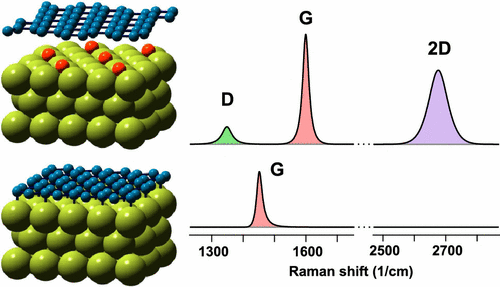Raman spectra of graphene on strongly interacting metal surfaces
When light encounters molecules, the predominant mode of scattering is elastic scattering (Rayleigh). This scattering is responsible for the blue colour of the sky, for example. It is also possible for the incident photons to interact with the molecules in such a way that energy is either gained or lost so that the scattered photons are shifted in frequency and in phase. Such inelastic scattering is called Raman scattering.
The intensity of Raman scattering is about one-thousandth of that of Rayleigh scattering in liquids; for this reason it was not discovered experimentally until 1928 by C.V. Raman and K.S. Krishnan in liquids, and the same year by L. Mandelstam and G. Landsberg in crystals, even though its existence was predicted by A. Smekal in 1923, and again in 1925 by H. Kramers and W. Heisenberg. However, it was not until the development of the laser that the effect was put to use.
In Raman espectroscopy light from a laser is passed through a substance. The resulting inelastically scattered photons can be of either lower (Stokes) or higher (anti-Stokes) frequency than the incoming photon. As the new frequencies in the Raman spectrum of monochromatic light scattered by the substance are characteristic of the substance, the technique is widely used as a way of determining molecular structure and is a common tool in chemical analysis.
It is understandable, then, that Raman spectroscopy has become one of the most widely and intensively used tools for the characterization of graphene and related materials. The versatility of this method is due to its high sensitivity to tiny changes in the electronic structure and phonon dispersions.
But there is a problem. The efficiency of Raman spectroscopy greatly depends on the nature of the substrate on which the graphene is supported. When graphene is placed on a thin SiO2 film with a properly chosen thickness, the signal is multiplied many times due to the interference of light. Thus, SiO2 is one of the most common substrates for Raman studies of graphene.
Actually, chemical vapor deposition (CVD) is one of the most popular methods for the synthesis of graphene-based systems. As the thickness and properties of CVD-grown graphene layers are very sensitive to the synthesis conditions, it is highly important to have efficient methods for graphene diagnostics on the substrates that are used for CVD. Usually, these are transition metal substrates with Ni and Cu being the most popular and the possibilities of graphene fabrication directly on SiO2 are very limited. This makes Raman spectroscopy almost useless for studies of graphene on metals.

Regardless of the widely accepted opinion that there is no Raman signal from single-layer graphene when it is strongly bonded to a metal surface, previous studies of graphene/metal systems indicate that Raman scattering could be extremely sensitive to the peculiarities of the interface. It is clear that the relationship between the interface properties and the features of Raman spectra are currently not well understood. Now, a team of researchers from different Russian and German institutions, CFM and DIPC, present 1 Raman spectra of a graphene monolayer on Ni(111) and Co(0001) substrates.
The well-known graphene/Ni(111) and graphene/Co(0001) systems are appropriate objects for investigation of Raman scattering in graphene on strongly interacting surfaces. The lattice mismatch between graphene and the close-packed Ni and Co surfaces is in the range of 1−2%, and covalent bonding of carbon with metal allows the formation of lattice-matched (1 × 1) structures due to the stretching of graphene.
The sharp band appearing around 1587 cm-1 in the spectrum of graphene is the G band. The observed position and predictable behaviour of this band help to determine the layer thickness as the G band position is highly sensitive to the number of layers present in the sample and the strains on the graphene layer. The researchers report the successful observation of the G band in the Raman spectra of the graphene/Ni and graphene/Co systems. The stretching of graphene is reflected in a record-breaking shift of the G band by more than 100 cm−1 relative to the case of freestanding graphene. Of course, the signal is much weaker in comparison to that of the classical graphene/SiO2 system, but it is in any case resolvable.
After comprehensive characterization with electron diffraction and photoelectron spectroscopy they show that Raman spectroscopy provides useful information that is fully consistent with other methods. These results demonstrate that Raman spectroscopy remains a helpful method for the characterization of graphene even on strongly interacting transition metal surfaces.
Author: César Tomé López is a science writer and the editor of Mapping Ignorance.
References
- Dmitry Yu. Usachov, Valery Yu. Davydov, Vladimir S. Levitskii, Viktor O. Shevelev, Dmitry Marchenko, Boris V. Senkovskiy, Oleg Yu. Vilkov, Artem G. Rybkin, Lada V. Yashina, Evgueni V. Chulkov, Irina Yu. Sklyadneva, Rolf Heid, Klaus-Peter Bohnen, Clemens Laubschat, and Denis V. Vyalikh (2017) Raman Spectroscopy of Lattice-Matched Graphene on Strongly Interacting Metal Surfaces ACS Nano doi:: 10.1021/acsnano.7b02686 ↩